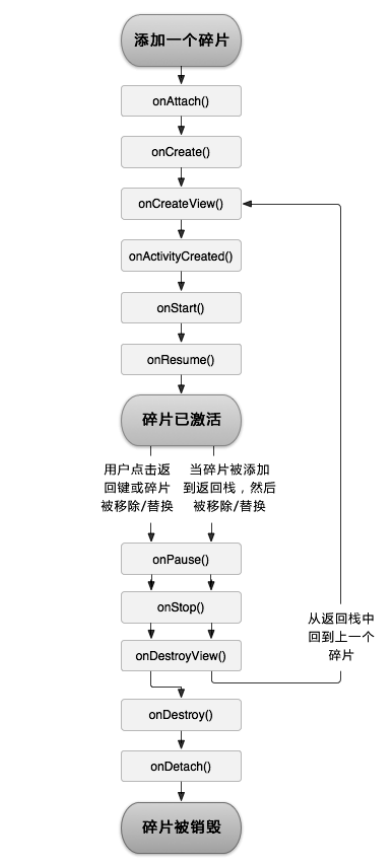Fragment,又称碎片,是一种可以嵌入到活动中个的UI片段,所以它跟Activity很像,同样能包含布局,同样都有自己的生命周期,它能让程序更加合理和充分的利用大屏幕的控件,所以在大屏幕的应用中十分广泛。
简单的使用方法
首先我们创建两个fragment的类
public class LeftFragment extends Fragment {
@Override
public View onCreateView(LayoutInflater inflater, ViewGroup container,
Bundle savedInstanceState) {
View view = inflater.inflate(R.layout.left_fragment, container, false);
return view;
}
}public class RightFragment extends Fragment {
@Override
public View onCreateView(LayoutInflater inflater, ViewGroup container,
Bundle savedInstanceState) {
View view = inflater.inflate(R.layout.right_fragment, container, false);
return view;
}
} 这里我们主要在界面左右分别添加一个fragment,在activity_main.xml的布局文件中的代码如下:
<LinearLayout xmlns:android="http://schemas.android.com/apk/res/android"
android:layout_width="match_parent"
android:layout_height="match_parent" >
<fragment
android:id="@+id/left_fragment"
android:name="com.example.fragmenttest.LeftFragment"
android:layout_width="0dp"
android:layout_height="match_parent"
android:layout_weight="1" />
<fragment
android:id="@+id/right_fragment"
android:name="com.example.fragmenttest.RightFragment"
android:layout_width="0dp"
android:layout_height="match_parent"
android:layout_weight="1" />
</LinearLayout>这里我们只要注意一点,在使用<fragment>标签在布局中添加碎片,要通过android:name属性来显示指明要添加的碎片名,注意一定要把包名加上。
动态添加碎片
在上面代码基础上修改代码,在创建一个fragment
<LinearLayout xmlns:android="http://schemas.android.com/apk/res/android"
android:layout_width="match_parent"
android:layout_height="match_parent"
android:background="#ffff00"
android:orientation="vertical" >
<TextView
android:layout_width="wrap_content"
android:layout_height="wrap_content"
android:layout_gravity="center_horizontal"
android:textSize="20sp"
android:text="This is another right fragment"
/>
</LinearLayout>public class AnotherRightFragment extends Fragment {
@Override
public View onCreateView(LayoutInflater inflater, ViewGroup container,
Bundle savedInstanceState) {
View view = inflater.inflate(R.layout.another_right_fragment,
container, false);
return view;
}
}接下来修改activity_main.xml,代码如下:
<LinearLayout xmlns:android="http://schemas.android.com/apk/res/android"
android:layout_width="match_parent"
android:layout_height="match_parent">
<fragment
android:id="@+id/left_fragment"
android:name="com.example.fragmenttest.LeftFragment"
android:layout_width="0dp"
android:layout_height="match_parent"
android:layout_weight="1" />
<FrameLayout
android:id="@+id/right_layout"
android:layout_width="0dp"
android:layout_height="match_parent"
android:layout_weight="1" >
<fragment
android:id="@+id/right_fragment"
android:name="com.example.fragmenttest.RightFragment"
android:layout_width="match_parent"
android:layout_height="match_parent" />
</FrameLayout>
</LinearLayout>我们将右侧的fragment放在FrameLayout中,然后我们在代码中替换FrameLayout的内容,从而实现动态添加碎片的功能,修改MainActivity的代码:
public class MainActivity extends Activity implements OnClickListener {
@Override
protected void onCreate(Bundle savedInstanceState) {
super.onCreate(savedInstanceState);
setContentView(R.layout.activity_main);
Button button = (Button) findViewById(R.id.button);
button.setOnClickListener(this);
}
@Override
public void onClick(View v) {
switch (v.getId()) {
case R.id.button:
AnotherRightFragment fragment = new AnotherRightFragment();
FragmentManager fragmentManager = getFragmentManager();
FragmentTransaction transaction = fragmentManager.
beginTransaction();
transaction.replace(R.id.right_layout, fragment);
transaction.commit();
break;
default:
break;
}
}
}结合代码可以看出,动态添加碎片主要分为5步:
1、创建待添加的碎片实例;
2、获取到FragmentManager,在活动中可以直接调用getFragmentManager()方法得到;
3、开启一个FragmentTransaction事务,通过调用beginTransaction()方法开启;
4、向容器内加入碎片,一般使用replace()方法来实现,需要传入容器的id和待添加的fragment实例;
5、提交事务,调用commit()方法来完成;
碎片的生命周期
这里重点看以下几个回调:
1. onAttach()
当碎片和活动建立关联的时候调用。
2. onCreateView()
为碎片创建视图(加载布局)时调用。
3. onActivityCreated()
确保与碎片相关联的活动一定已经创建完毕的时候调用。
4. onDestroyView()
当与碎片关联的视图被移除的时候调用。
5. onDetach()
当碎片和活动解除关联的时候调用。























 1091
1091

 被折叠的 条评论
为什么被折叠?
被折叠的 条评论
为什么被折叠?








